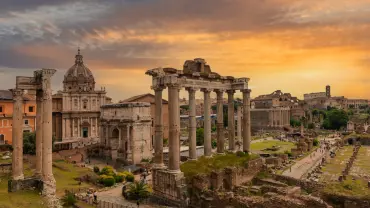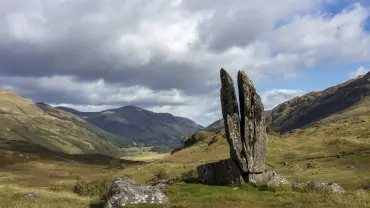Easter Island, a remote volcanic island in the southeastern Pacific Ocean, has long captivated the imagination of historians, archaeologists, and travellers alike with its enigmatic Moai statues.
Who made the Easter Island statues is an easy one to answer. They were carved by the native Rapa Nui people most likely between the thirteenth and sixteenth centuries. But the question that has stumped the world since they were first discovered in the early eighteenth century by European explorers, is why.
The Easter Island Moai mystery persists, making it a subject of ongoing fascination and study. Why were almost a thousand intricately carved statues, some weighing over eighty tonnes, created? What were they used for? Why were they placed so strategically?
Let’s take a trip to one of the most remote spots on the planet in an attempt to shed light on the Easter Island mystery.
A Short History of Easter Island

Sunrise on Easter Island. (Credit: traumlichtfabrik via Getty Images)
Easter Island, also known as Rapa Nui, is today a special territory of Chile located in the southeastern Pacific Ocean. The 63 sq. mile volcanic island is one of the most remote inhabited places on Earth. The closest inhabited island is Pitcairn Island, just over 1,300 miles to the west, and the nearest continental landmass is the Chilean coast, around 2,200 miles to the east.
It was named Easter Island because it’s believed the first European ship to visit, captained by Dutch explorer Jacob Roggeveen, arrived on the island on Easter Sunday, 5 April 1722.
The exact time when inhabitants first settled on Easter Island remains uncertain. Initially thought to be of South American origin, it’s now established that they were from Polynesia. Estimates of their arrival range from as early as 300 AD to around 1200 AD. Despite the lack of extensive written or oral records, the thriving nature of this society is evident from the many large Moai statues and other artefacts found throughout the island.
A Rapid Decline

Moai statues at Rano Raraku quarry on Easter Island (Rapa Nui), Chile. (Credit: Mike Steinhauer via Getty Images)
From around the fifteenth or sixteenth century, the civilisation began a steep decline. It’s generally attributed to a combination of environmental degradation and external factors. Intensive deforestation – possibly for agricultural expansion and also for transportation of the massive Moai statues – led to soil erosion. This reduced crop yields, and led to a diminished food supply.
This environmental strain, compounded by the arrival of Europeans in the eighteenth century, brought diseases against which the inhabitants had no immunity, resulting in a dramatic population decline. Additionally, resource depletion and ecological imbalance likely sparked internal conflicts, exacerbating the society’s downfall.
From a population high of around 15,000 in the fifteenth century, by the late 1870s it’s believed just over 100 remained, largely due to slave raiders, disease and relocation. The most recent Chilean census conducted in 2017 puts the population at around 7,800. Alongside this, the island attracts around 100,000 tourists every year, most of whom come to marvel at the Easter Island head mystery.
The Magnificent Moai Statues

Ahu Tongariki is the largest site of moai in a row (Credit: Patricia Hamilton via Getty Images)
Who made the Easter Island statues? They were created by the Rapa Nui people, probably between 1250 and 1500, and are monolithic depictions of large human heads with bodies but no legs.
There are around 900 Moai statues in total, dotted all over Easter Island and many stand on platforms known as ahu. About half remain in the quarry in which they were created, while the rest are scattered around the island’s perimeter. It’s also believed that there may be as many as 600 more in varying states of completion and more statues are constantly being discovered.
Most of the statues are carved from a compressed volcanic ash called tuff, but some are carved from basalt (a volcanic rock), trachyte, which is formed by the rapid cooling of volcanic lava, and red scoria, an extremely fragile type of rock.
On average, the statues are around four metres high and weigh eleven tonnes. The tallest, named Paro, was close to ten metres tall and weighed over 80 tonnes. The heaviest statue weighs 86 tonnes, and scientists have postulated that one of the unfinished statues would be well over 20 metres tall and weigh something close to 150 tonnes.
While we know much about the age and physical attributes of the Moai statues, this Easter Island mystery raises many more questions than it answers.
Why were the Moai Statues Made?

Moai statues on Easter Island. (Credit: RachelKramer via Getty Images)
This is the question at the heart of the Easter Island Moai mystery. The prevailing theories regarding the purpose of the Moai statues on Easter Island suggest a combination of religious, social, and political motivations. Here are a number of the most common theories about why the Moai Statues were made:
Ancestral Veneration
The most widely accepted theory is that the Moai represented deified ancestors. It’s believed that the Rapa Nui people constructed these statues to honour their ancestors, leaders, or other important figures. This veneration was thought to protect the community, with the Moai serving as guardians watching over the villages.
Religious or Ceremonial Significance
The statues may have had significant religious and ceremonial importance. They could have been involved in rituals or perhaps it was believed that they held sacred power. The exact nature of these religious practices remains largely speculative but is thought to be central to the Rapa Nui’s spiritual life.
Social or Political Significance
Constructing a Moai was a considerable endeavour, requiring resources, labour, and organisation. Therefore, the creation of these statues, and their physical size, might have been a way to demonstrate a clan’s or leader’s social and political power.
Location of Fresh Water
In recent years, scientists have suggested that the strategic location of the Moai statues may have pointed to sources of freshwater, crucial on a tiny island surrounded by millions of square kilometres of salt water. They may have served as a guide to underground aquifers. Some theories go further, postulating that the size of the statue and the platform may have been an indication of the quantity or quality of the water at a particular site.
Astronomical Alignment or Environmental Harmony
Some researchers propose that the placement of the Moai may have had astronomical significance, possibly aligned with important celestial events like solstices or equinoxes, although this theory is less established. Another interpretation suggests that the Moai represented a form of respect or harmony with the environment, embodying the Rapa Nui’s connection to their land and its resources.
While these theories about the Moai Statues offer insight into the potential reasons behind their construction, the exact purpose remains a subject of debate among scholars. While many aspects of the statues’ significance to the Rapa Nui people is still in question, the Easter Island head mystery remains shrouded in conjecture.
In addition to not knowing why they were made, archaeologists and assorted experts are still unsure how they were moved. Theories range from the use of ropes, rolling logs or makeshift wooden sleds, to being ‘walked’ using upright ropes and perhaps even a sophisticated knowledge of physics and engineering. Again, the Easter Island mystery remains exactly that.
The Moai Mystique: The Easter Island Mystery

Moai of Ahu Tongariki facing Rano Raraku (Credit: Marko Stavric Photography via Getty Images)
The Moai statues of Easter Island stand as enduring enigmas, silent yet powerful symbols of a society whose complexities are still being unravelled. Crafted by the Rapa Nui people, these monumental figures embody the ingenuity, spiritual beliefs, and societal structures of a culture that thrived in isolation.
Despite the challenges posed by environmental degradation and external influences leading to the decline of the Rapa Nui, the Easter Island Moai mystery continues to intrigue and perplex. The Moai statues remain a profound testament to the intricacies of history, culture, and humankind’s unending quest to understand the world’s great wonders.












